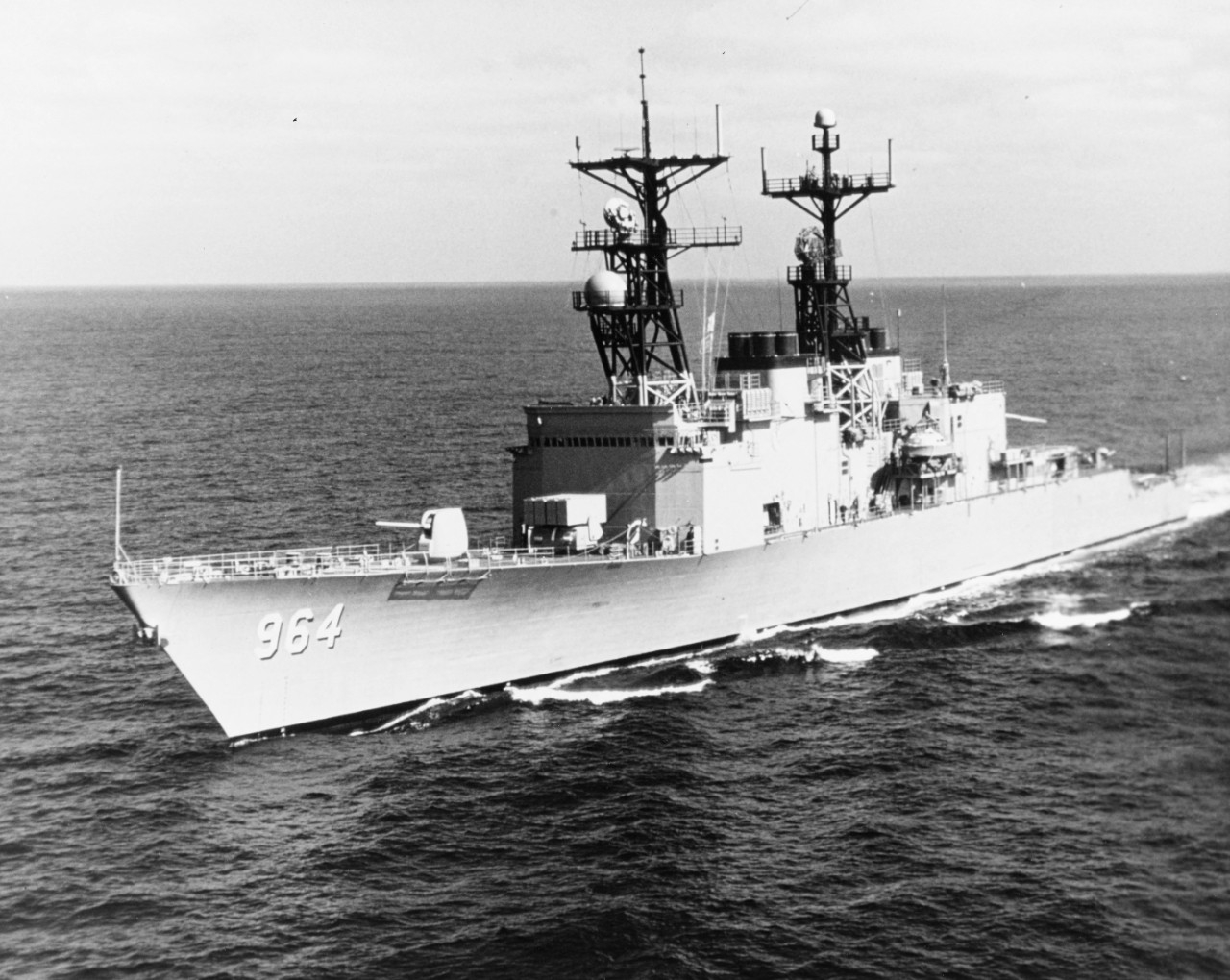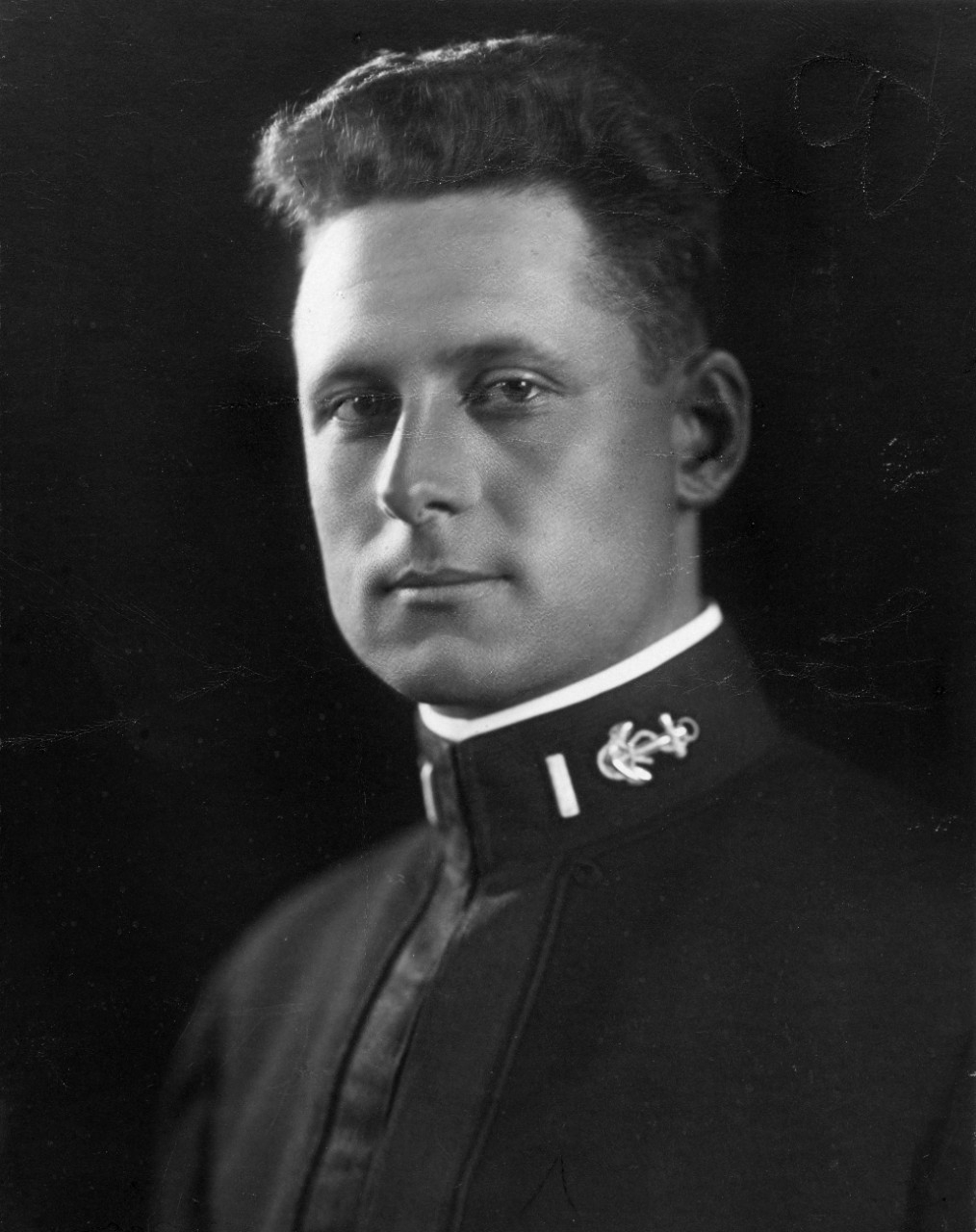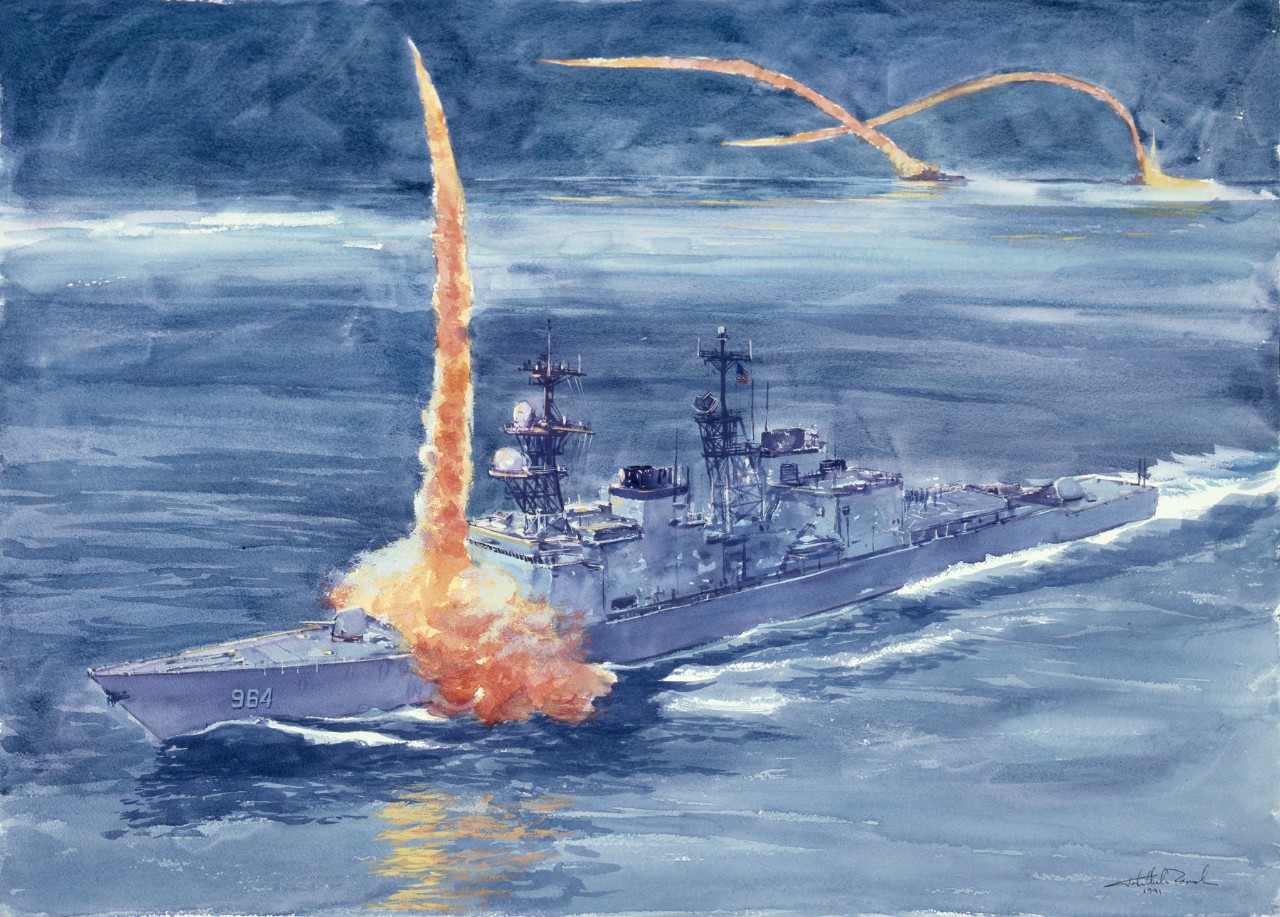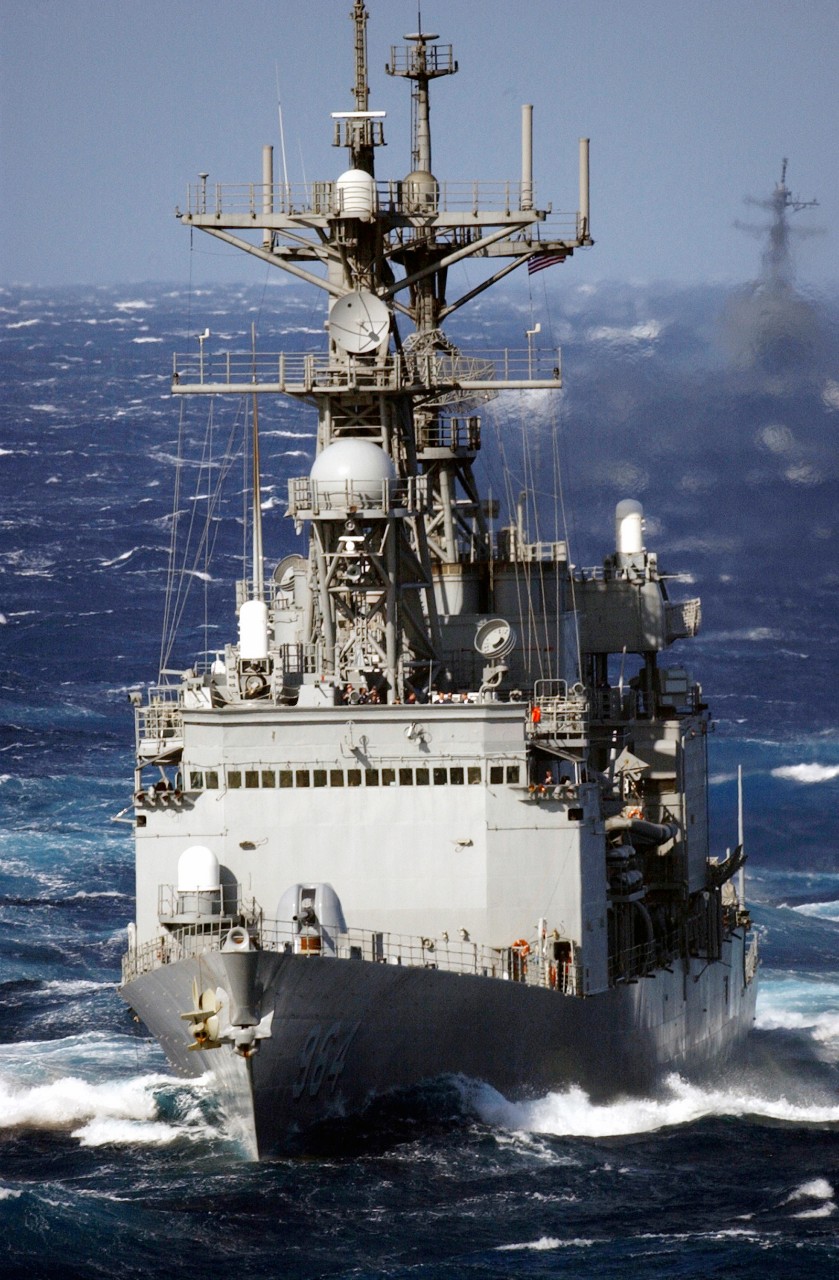USS Paul F. Foster (DD-964)
1976–2003
The first U.S. naval vessel named for Vice Admiral Paul Frederick Foster, born in Wichita, Kansas, on 25 March 1889.
Appointed to the U.S. Naval Academy, Paul Frederick Foster graduated with the class of 1911 and commissioned as an ensign. Upon graduation, he received orders to cruiser Washington (CA-11), serving until December of that year, when he was transferred to the newly commissioned battleship Utah (BB-31). While serving on board Utah, he participated in the Mexican Campaign and was awarded the Congressional Medal of Honor for “Distinguished conduct in battle engagements of Vera Cruz (21-22 April 1914), fighting at the head of his company, Ensign Foster was eminent and conspicuous in his conduct, leading his men with skill and courage.” While commanding AL-2 (SS-41), Lt. Cmdr. Foster received the Distinguished Service Medal for “exceptionally meritorious service in a duty of great responsibility in an encounter with an enemy submarine (UB-65) on 10 July 1918, in which the enemy submarine was sunk.” In January 1924, Lt. Cmdr. Foster received orders to Philadelphia to assist in fitting out light cruiser Trenton (CL-11), serving on board as Engineer Officer upon the ship’s commissioning in April of that year. In January 1927, he received the Navy Cross for extraordinary heroism in the aftermath of a turret explosion on board Trenton. Lt. Cmdr. Foster became the first man to receive all three of the Navy’s highest awards. Recalled to active duty in 1941 (after resigning his commission in March 1927), Admiral Foster served on the Navy Inspector General’s Staff during World War II, conducting three major inspections at the personal direction of President Franklin D. Roosevelt. In June 1954, Admiral Foster joined the staff of the Atomic Energy Commission as special assistant to the General Manager for International Activities. Later appointed to the International Atomic Energy Agency in Vienna, Austria, with the rank of Ambassador, Adm. Foster served in the position until 1961. He died in 1972 in Virginia Beach, Va., at the age of 83.
(DD-964; displacement 7,800 tons; length 563' 4"; beam 55'; draft 29'; speed 30 knots; complement 262; armament 2 5-inch guns, MK 45 gun mounts, 1 Sea Sparrow SAM, 8 Mk 112 antisubmarine rocket (ASROC) launchers, 2 Mk 32 torpedo launchers; class Spruance)
Paul F. Foster was laid down on 6 February 1973, at Pascagoula, Miss., by Litton Ingalls; launched on 22 February 1974 and sponsored by Mrs. Isabelle L. Foster, Adm. Foster’s wife; and commissioned on 21 February 1976.
The first Spruance-class destroyer assigned to the U.S. Pacific Fleet, Paul F. Foster also became the first to fire a NATO Sea Sparrow missile. She was also the first to land a Boeing Vertol CH-46 Sea Knight helicopter on board her deck. Steaming out of San Diego, she became the first Spruance-class destroyer to deploy to the Western Pacific in March 1978.
Paul F. Foster steamed to Long Beach Naval Shipyard for a regular overhaul (30 September-31 December 1980). Assigned to Destroyer Squadron (DesRon) 23 after completion of the first such overhaul by a Spruance-class destroyer, she made way for her new homeport at San Diego.
Getting underway on 30 April 1982, Paul F. Foster left San Diego for a Western Pacific (WestPac) cruise to the Indian Ocean. On 30 May, she crossed into the Southern Hemisphere and held ceremonies with King Neptunus Rex. After port visits in Oman (4-8 July) and Pakistan (25-28 July), the destroyer returned to her homeport in San Diego (17 October).
On 7 January 1983, Paul F. Foster arrived to her new homeport at Long Beach, and entered dry dock four days later for replacement of waste heat boilers and replaced all steam auxiliary equipment with (except galley and laundry) electrical equipment. Leaving dry dock on 13 March, she began workups off San Diego through the end of the year.
Deploying for a WestPac cruise on 28 August 1984, Paul F. Foster participated in operational exercises with the Royal Australian and New Zealand navies (SANDGROPER 84), as well as with the Japanese Maritime Self Defense Force (ASWEX 85-IJA). She also participated in FLEETEX 85, operations alongside three carrier battle groups. Paul F. Foster returned to her homeport at Long Beach on 20 December.
On 16 August 1986, as a member of Battle Group Charlie, Paul F. Foster rescued six sailors washed overboard from Carl Vinson (CVN-70) in heavy seas. She later participated in Exercise CROWEATER 86, alongside Royal Australian Navy vessels, before proceeding to Subic Bay (27-31 December), and finally transiting Sunda Strait into the Java Sea on New Year’s Eve.
During a WestPac deployment in 1987, Paul F. Foster received a Meritorious Unit Commendation while part of Battle Group Charlie, Northern Pacific Group, operating “during extreme cold weather operations” (16 January-2 February) in the Northern Pacific. Both airmanship and seamanship were tested yet safely conducted amidst blinding snowstorms, freezing temperatures, and twenty-foot seas. She completed the deployment on 6 February.
Completing a regular overhaul at Northwest Marine and Iron Works, Portland, Oregon, on 1 July 1988, Paul F. Foster received over 55 major ship alterations. She received two new weapons systems, including a Vertical Launch System for her Tomahawk cruise missiles, and a Close-In Weapons System (CIWS) for anti-missile defense.
Getting underway for a six-month deployment on 24 February-24 August 1989, the destroyer conducted READIEX-89 (25 February-7 March) and a PASSEX alongside the Royal Australian Navy (06-07 July).
Paul Foster (DD-964), Missouri (BB-63) and Bunker Hill (CG-52) on the horizon at 3 a.m. fire off the first missiles in the opening round of the Iraqi war. Described by one of the junior officers, “It looked like Roman candle going off on the horizon as the missiles arced over on their way to Iraqi.” Painting, watercolor on paper; by John Charles Roach; 1991; framed dimensions 34H X 39W. Accession#: 92-007-J.
Commander, DesRon 7, awarded his Golden Arrow flag to Paul F. Foster for outstanding ASW proficiency during exercises while underway (27 September-5 October 1990) for COMPUTEX 90-3. The destroyer deployed for the Persian Gulf on 8 December to support Operation DESERT SHIELD. Participating in Operation DESERT STORM, Paul F. Foster unleashed a salvo of Tomahawk cruise missiles from her vertical launcher in the opening barrage of the war during the early morning hours of 17 January 1991. Over the next eight days, she fired 40 Tomahawk cruise missiles towards military targets in Iraq. Only one U.S. Navy ship fired more missiles during the Gulf War. Paul F. Foster’s crewmembers received the Combat Action Ribbon, Navy Unit Commendation, National Defense Service Medal, Southwest Asia Service Medal, and the Kuwait Liberation Medal, for service during Operations DESERT SHIELD/DESERT STORM.
The destroyer Paul F. Foster (DD-964) approached the starboard side of the Military Sealift Command ship Rappahannock (T-AO 204) to take on fuel, 29 October 2002. Replenishments at sea enable Navy ships to remain deployed at sea for indefinite periods of time. U.S. Navy photo by Photographers Mate 3rd Class William H. Ramsey. 021029-N-0120R-002
On 20 June 1993, Paul F. Foster deployed for her eighth deployment to the Arabian Gulf, spending the majority of the next three months patrolling alongside carrier Ranger (CV-61). The destroyer later steamed for home at the end of the year, spending the holidays in Hong Kong.
Upon her return to the Persian Gulf in July 1994, Paul F. Foster conducted Exercise GULFEX XXV in the Central Arabian Gulf. On 30 September 1995, she officially changed homeports from Long Beach to Everett, Wash., despite physically remaining in Long Beach. In May 1997, Paul F. Foster operated alongside the Constellation (CV-64) Battle Group during FLEETEX 97-1, before suffering a casualty to her starboard shaft on 2 May. Proceeding to Jebel Ali, workers completed repairs to her shaft eight days later.
In August 1998, Paul F. Foster received extensive repairs to her fire main system. On 11 December, she participated in a MISSILEX and successfully fired at and destroyed two targets using the NATO Sea Sparrow System. Two days later, she conducted a Naval Surface Fire Support (NSFS) FIREX-1 at San Clemente Range.
On 4 February 1999, Paul F. Foster steamed in company with Hewitt (DD-966) and Rodney M. Davis (FFG-60) to Hong Kong, People’s Republic of China, arriving on 19 February. On 14 March, the destroyer chopped to the U.S. Fifth Fleet and conducted a transit of the Straits of Hormuz. She participated in EAGER SENTRY 99 alongside Kuwaiti and British ships (10-11 April), focusing on littoral defense and tactical maneuvering.
During a RIMPAC exercise on 10 July 2002, Paul F. Foster fired 30 rounds from her two 5-inch guns and one defensive missile, helping to sink decommissioned fast frigate Harold E. Holt (FF-1074). On 24 November, Paul F. Foster became the first U.S. Navy vessel in a year to make a port call to China, after China and the United States blamed one another for an April 2001 aircraft collision between a U.S. signals intelligence aircraft and a Chinese fighter aircraft over the South China Sea.
Decommissioned on 14 March 2003, ex-Paul F. Foster was turned over 13 days later to Naval Surface Warfare Center, Port Hueneme Division, as the U.S. Navy’s new Self Defense Test Ship (SDTS). The only ship of her class still in existence, the destroyer featured in three episodes of popular television show NCIS, and appeared in the 1980 feature-film “The Final Countdown,” as part of the Nimitz (CVN-68) Battle Group, before the carrier went back in time to 1941 Pearl Harbor.
Commanding Officers Date Assumed Command
Cmdr. George E. Sullivan III |
21 February 1976 |
Cmdr. Albert L. Kaiss |
07 April 1978 |
Cmdr. Theodore C. “Ted” Lockhart |
11 May 1980 |
Cmdr. Laurence H. Turner, Jr. |
17 May 1982 |
Cmdr. Raymond P. Conrad |
15 June 1984 |
Cmdr. Robert B. Danberg |
01 November 1986 |
Cmdr. Timothy M. Ahern |
11 February 1989 |
Cmdr. Edward J. Kujat |
23 February 1991 |
Cmdr. Kim S. Buike |
28 November 1992 |
Cmdr. David A. Gelenter |
06 August 1994 |
Cmdr. David M. Armitage |
04 August 1995 |
Cmdr. Thomas S. Abernathy |
17 June 1997 |
Cmdr. Thomas J. Strei, Jr. |
06 November 1998 |
Cmdr. Thomas L. Reese |
05 June 2000 |
Cmdr. John C. “Chuck” Nygaard |
11 February 2002 |
Guy Joseph Nasuti
13 November 2019






